A Theoretical Comparative Study of CO2 Cascade Refrigeration Systems
Abstract
:1. Introduction
2. Materials and Methods
2.1. The Examined System
2.2. Mathematical Formulation
2.2.1. System Modeling
2.2.2. Environmental Evaluation of the System
2.3. Followed Methodology
- The system is examined in steady-state conditions.
- There is no pressure drop in the evaporator, condenser and heat exchanger.
- The throttling valve is assumed to be adiabatic and so the enthalpy is conserved.
- The outlet streams from the evaporator, condenser and cascade heat exchanger are assumed to be saturated state points.
- The temperature difference of the streams in the cascade heat exchanger is 5 K.
- The condenser temperature is 5 K higher than the ambient temperature and for the CO2/CO2 system, the gas cooler outlet temperature is 5 K higher than the ambient.
- The cooling capacity is 50 kW in all the cases.
- All the compressor isentropic efficiencies are calculated according to Equation (7).
- In the yearly analysis, the system is assumed to operate during all the year period.
2.4. Model Validation
3. Results and Discussion
3.1. Energetic Analysis of Different Operating Scenarios
3.2. Yearly Energetic and Environmental Analysis
4. Conclusions
- The COP of all the examined cascade systems is found to be higher than the reference scenario of the CO2/CO2 cascade configuration. The enhancements with the other systems are found from 10% up to 80% and they are higher for higher heat rejection temperatures.
- The most efficient working fluids energetically, in the high-temperature circuit, are R152a, NH3, R1270, R600, R600a and R290. The less efficient systems, except CO2, are the refrigerants with high GWP such as R507A and R404a.
- The maximum mean yearly COP is found for R152a/CO2 in all the evaporator temperatures and it is 2.381 for (Te = −35 °C), while the respective of CO2/CO2 is 1.901.
- The environmental index TEWI shows that the CO2/CO2 is not a so good choice with the value of 1659.2 for (Te = −35 °C), while the R1270 has 1326.9. The natural refrigerants, the R152a, R1234yf and R1234ze(E) have also relatively low TEWI. The reason for the high value in the CO2/CO2 system is the high indirect TEWI.
- It can be said that there is an overall optimum case because the most efficient choices have flammability and toxicity issues. R152a seems to be a promising choice but has a GWP of 124. So, for the final selection of the high-temperature circuit refrigerant, extra parameters such as the refrigerant cost and the legislation have to be taken into consideration in every case.
Author Contributions
Funding
Acknowledgments
Conflicts of Interest
Nomenclature
| COP | Coefficient of performance, - |
| COPm | Mean yearly coefficient of performance, - |
| Eel | Yearly electrical energy, kWh |
| h | Specific enthalpy, kJ kg−1 K−1 |
| L | Yearly leakage, kg |
| m | Mass flow rate, kg s−1 |
| M | Refrigerant mass, kg |
| Ν | Lifetime of the system, years |
| Q | Heat rate, kW |
| r | Pressure ratio, - |
| T | Temperature, °C |
| t | Time, hours |
| TEWI | Total equivalent warming impact, kg CO2,eq |
| W | Work consumption in the compressor, kW |
| Greek Symbols | |
| α | Recycling factor, - |
| β | Indirect emission factor, kg CO2,eq kWh−1. |
| ηis | Isentropic efficiency of the compressor, - |
| Subscripts and Superscripts | |
| am | Ambient |
| c | Condenser |
| car | Carnot |
| com | Compressor |
| e | Evaporator |
| is | Isentropic |
| m1 | Medium in low circuit |
| m2 | Medium in high circuit |
| opt | Optimum |
| r | Refrigerant |
| Abbreviations | |
| EES | Engineering Equation Solver |
| GWP | Global Warming Potential (100 years) |
| HC | Hydrocarbon |
| HFO | Hydrofluoroolefin |
| HO | Hydroolefin |
References
- Sanz-Kock, C.; Llopis, R.; Sánchez, D.; Cabello, R.; Torrella, E. Experimental evaluation of a R134a/CO2 cascade refrigeration plant. Appl. Therm. Eng. 2014, 73, 41–50. [Google Scholar] [CrossRef]
- Nebot-Andrés, L.; Llopis, R.; Sánchez, D.; Catalán-Gil, J.; Cabello, R. CO2 with Mechanical Subcooling vs. CO2 Cascade Cycles for Medium Temperature Commercial Refrigeration Applications Thermodynamic Analysis. Appl. Sci. 2017, 7, 955. [Google Scholar] [CrossRef]
- Gullo, P.; Elmegaard, B.; Cortella, G. Energy and environmental performance assessment of R744 booster supermarket refrigeration systems operating in warm climates. Int. J. Refrig. 2016, 64, 61–79. [Google Scholar] [CrossRef] [Green Version]
- European Commission. Regulation (EU) No 517/2014 of the European Parliament and of the Council of 16th April 2014 on Fluorinated Greenhouse Gases and Repealing Regulation (EC) No 842/2006; European Commission: Brussels, Belgium; Luxembourg, 2014. [Google Scholar]
- Bellos, E.; Tzivanidis, C. Investigation of the Environmentally-Friendly Refrigerant R152a for Air Conditioning Purposes. Appl. Sci. 2019, 9, 119. [Google Scholar] [CrossRef]
- Chen, Y.; Gu, J. The optimum high pressure for CO2 transcritical refrigeration systems with internal heat exchangers. Int. J. Refrig. 2005, 28, 1238–1249. [Google Scholar] [CrossRef]
- Torrella, E.; Sánchez, D.; Llopis, R.; Cabello, R. Energetic evaluation of an internal heat exchanger in a CO2 transcritical refrigeration plant using experimental data. Int. J. Refrig. 2011, 34, 40–49. [Google Scholar] [CrossRef]
- Cavallini, A.; Cecchinato, L.; Corradi, M.; Fornasieri, E.; Zilio, C. Two-stage transcritical carbon dioxide cycle optimisation: A theoretical and experimental analysis. Int. J. Refrig. 2005, 28, 1274–1283. [Google Scholar] [CrossRef]
- Sarkar, J.; Agrawal, N. Performance optimization of transcritical CO2 cycle with parallel compression economization. Int. J. Therm. Sci. 2010, 49, 838–843. [Google Scholar] [CrossRef]
- Gullo, P.; Elmegaard, B.; Cortella, G. Advanced exergy analysis of a R744 booster refrigeration system with parallel compression. Energy 2016, 107, 562–571. [Google Scholar] [CrossRef] [Green Version]
- Chesi, A.; Esposito, F.; Ferrara, G.; Ferrari, L. Experimental analysis of R744 parallel compression cycle. Appl. Energy 2014, 135, 274–285. [Google Scholar] [CrossRef]
- Koeln, J.P.; Alleyne, A.G. Optimal subcooling in vapor compression systems via extremum seeking control: Theory and experiments. Int. J. Refrig. 2014, 43, 14–25. [Google Scholar] [CrossRef]
- Llopis, R.; Nebot-Andrés, L.; Cabello, R.; Sánchez, D.; Catalán-Gil, J. Experimental evaluation of a CO2 transcritical refrigeration plant with dedicated mechanical subcooling. Int. J. Refrig. 2016, 69, 361–368. [Google Scholar] [CrossRef]
- Dai, B.; Liu, S.; Li, H.; Sun, Z.; Song, M.; Yang, Q.; Ma, Y. Energetic performance of transcritical CO2 refrigeration cycles with mechanical subcooling using zeotropic mixture as refrigerant. Energy 2018, 150, 205–221. [Google Scholar] [CrossRef]
- Sánchez, D.; Catalán-Gil, J.; Llopis, R.; Nebot-Andrés, L.; Cabello, R.; Torrella, E. Improvements in a CO2 transcritical plant working with two different subcooling systems. In Proceedings of the 12th IIR Gustav Lorentzen Conference on Natural Refrigerants (GL2016), Edinburgh, UK, 21–24 August 2016. [Google Scholar]
- Nakagawa, M.; Marasigan, A.R.; Matsukawa, T.; Kurashina, A. Experimental investigation on the effect of mixing length on the performance of two-phase ejector for CO2 refrigeration cycle with and without heat exchanger. Int. J. Refrig. 2011, 34, 1604–1613. [Google Scholar] [CrossRef]
- Chen, G.; Volovyk, O.; Zhu, D.; Ierin, V.; Shestopalov, K. Theoretical analysis and optimization of a hybrid CO2 transcritical mechanical compression—Ejector cooling cycle. Int. J. Refrig. 2017, 74, 86–94. [Google Scholar] [CrossRef]
- Yang, J.L.; Ma, Y.T.; Liu, S.C. Performance investigation of transcritical carbon dioxide two-stage compression cycle with expander. Energy 2007, 32, 237–245. [Google Scholar] [CrossRef]
- Catalán-Gil, J.; Sánchez, D.; Llopis, R.; Nebot-Andrés, L.; Cabello, R. Energy Evaluation of Multiple Stage Commercial Refrigeration Architectures Adapted to F-Gas Regulation. Energies 2018, 11, 1915. [Google Scholar] [CrossRef]
- Available online: https://www.ghgprotocol.org/sites/default/files/ghgp/Global-Warming-Potential-Values%20%28Feb%2016%202016%29_1.pdf (accessed on 5 November 2018).
- Available online: https://en.wikipedia.org/wiki/List_of_refrigerants (accessed on 5 November 2018).
- Abas, N.; Kalair, A.R.; Khan, N.; Haider, A.; Saleem, Z.; Saleem, M.S. Natural and synthetic refrigerants, global warming: A review. Renew. Sustain. Energy Rev. 2018, 90, 557–569. [Google Scholar] [CrossRef]
- Bingming, W.; Huagen, W.; Jianfeng, L.; Ziwen, X. Experimental investigation on the performance of NH3/CO2 cascade refrigeration system with twin-screw compressor. Int. J. Refrig. 2009, 32, 1358–1365. [Google Scholar] [CrossRef]
- Lee, T.-S.; Liu, C.-H.; Chen, T.-W. Thermodynamic analysis of optimal condensing temperature of cascade-condenser in CO2/NH3 cascade refrigeration systems. Int. J. Refrig. 2006, 29, 1100–1108. [Google Scholar] [CrossRef]
- Rezayan, O.; Behbahaninia, A. Thermoeconomic optimization and exergy analysis of CO2/NH3 cascade refrigeration systems. Energy 2011, 36, 888–895. [Google Scholar] [CrossRef]
- Yilmaz, B.; Mancuhan, E.; Erdonmez, N. A Parametric Study on a Subcritical CO2/NH3 Cascade Refrigeration System for Low Temperature Applications. ASME J. Energy Resour. Technol. 2018, 140, 092004. [Google Scholar] [CrossRef]
- Gholamian, E.; Hanafizadeh, P.; Ahmadi, P. Advanced exergy analysis of a carbon dioxide ammonia cascade refrigeration system. Appl. Therm. Eng. 2018, 137, 689–699. [Google Scholar] [CrossRef]
- Dokandari, D.A.; Hagh, A.S.; Mahmoudi, S.M.S. Thermodynamic investigation and optimization of novel ejector-expansion CO2/NH3 cascade refrigeration cycles (novel CO2/NH3 cycle). Int. J. Refrig. 2014, 46, 26–36. [Google Scholar] [CrossRef]
- Bhattacharyya, S.; Bose, S.; Sarkar, J. Exergy maximization of cascade refrigeration cycles and its numerical verification for a transcritical CO2–C3H8 system. Int. J. Refrig. 2007, 30, 624–632. [Google Scholar] [CrossRef]
- Dubey, A.M.; Kumar, S.; Agrawal, G.D. Thermodynamic analysis of a transcritical CO2/propylene (R744–R1270) cascade system for cooling and heating applications. Energy Convers. Manag. 2014, 86, 774–783. [Google Scholar] [CrossRef]
- Megdouli, K.; Ejemni, N.; Nahdi, E.; Mhimid, A.; Kairouani, L. Thermodynamic analysis of a novel ejector expansion transcritical CO2/N2O cascade refrigeration (NEETCR) system for cooling applications at low temperatures. Energy 2017, 128, 586–600. [Google Scholar] [CrossRef]
- Bhattacharyya, S.; Garai, A.; Sarkar, J. Thermodynamic analysis and optimization of a novel N2O–CO2 cascade system for refrigeration and heating. Int. J. Refrig. 2009, 32, 1077–1084. [Google Scholar] [CrossRef]
- Sanchez, D.; Llopis, R.; Cabello, R.; Catalán-Gil, J.; Nebot-Andrés, L. Conversion of a direct to an indirect commercial (HFC134a/CO2) cascade refrigeration system: Energy impact analysis. Int. J. Refrig. 2017, 73, 183–199. [Google Scholar] [CrossRef]
- Cabello, R.; Sánchez, D.; Llopis, R.; Catalán, J.; Nebot-Andrés, L.; Torrella, E. Energy evaluation of R152a as drop in replacement for R134a in cascade refrigeration plants. Appl. Therm. Eng. 2017, 110, 972–984. [Google Scholar] [CrossRef] [Green Version]
- Da Silva, A.; Filho, E.P.B.; Antunes, A.H.P. Comparison of a R744 cascade refrigeration system with R404A and R22 conventional systems for supermarkets. Appl. Therm. Eng. 2012, 41, 30–35. [Google Scholar] [CrossRef]
- Byrne, P.; Miriel, J.; Lenat, Y. Design and simulation of a heat pump for simultaneous heating and cooling using HFC or CO2 as a working fluid. Int. J. Refrig. 2009, 32, 1711–1723. [Google Scholar] [CrossRef]
- Tsamos, K.M.; Ge, Y.T.; Santosa, I.; Tassou, S.A.; Bianchi, G.; Mylona, Z. Energy analysis of alternative CO2 refrigeration system configurations for retail food applications in moderate and warm climates. Energy Convers. Manag. 2017, 150, 822–829. [Google Scholar] [CrossRef]
- Nasruddin; Sholahudin, S.; Giannetti, N.; Arnas. Optimization of a cascade refrigeration system using refrigerant C3H8 in high temperature circuits (HTC) and a mixture of C2H6/CO2 in low temperature circuits (LTC). Appl. Therm. Eng. 2016, 104, 96–103. [Google Scholar] [CrossRef]
- Beshr, M.; Aute, V.; Sharma, V.; Abdelaziz, O.; Fricke, B.; Radermacher, R. A comparative study on the environmental impact of supermarket refrigeration systems using low GWP refrigerants. Int. J. Refrig. 2015, 56, 154–164. [Google Scholar] [CrossRef] [Green Version]
- Di Nicola, G.; Polonara, F.; Stryjek, R.; Arteconi, A. Performance of cascade cycles working with blends of CO2 + natural refrigerants. Int. J. Refrig. 2011, 34, 1436–1445. [Google Scholar] [CrossRef]
- Colorado, D.; Hernández, J.A.; Rivera, W. Comparative study of a cascade cycle for simultaneous refrigeration and heating operating with ammonia, R134a, butane, propane, and CO2 as working fluids. Int. J. Sustain. Energy 2012, 31, 365–381. [Google Scholar] [CrossRef]
- Cecchinato, L.; Corradi, M.; Minetto, S. Energy performance of supermarket refrigeration and air conditioning integrated systems working with natural refrigerants. Appl. Therm. Eng. 2012, 48, 378–391. [Google Scholar] [CrossRef]
- Getu, H.M.; Bansal, P.K. Thermodynamic analysis of an R744–R717 cascade refrigeration system. Int. J. Refrig. 2008, 31, 45–54. [Google Scholar] [CrossRef]
- Purohit, N.; Sharma, V.; Sawalha, S.; Fricke, B.; Llopis, R.; Dasgupta, M.S. Integrated supermarket refrigeration for very high ambient temperature. Energy 2018, 165A, 572–590. [Google Scholar] [CrossRef]
- Brown, J.S.; Yana-Motta, S.F.; Domanski, P.A. Comparitive analysis of an automotive air conditioning systems operating with CO2 and R134a. Int. J. Refrig. 2002, 25, 19–32. [Google Scholar] [CrossRef]
- AIRAH. Methods of Calculating Total Equivalent Warming Impact (TEWI) 2012. Available online: http://www.airah.org.au (accessed on 24 October 2018).
- Gullo, P.; Tsamos, K.M.; Hafner, A.; Banasiak, K.; Ge, Y.T.; Tassou, S.A. Crossing CO2 equator with the aid of multi-ejector concept: A comprehensive energy and environmental comparative study. Energy 2018, 164, 236–263. [Google Scholar] [CrossRef]
- F-Chart Software, Engineering Equation Solver (EES). 2015. Available online: http://www.fchart.com/ees (accessed on 5 November 2018).
- Available online: http://www.trnsys.com/ (accessed on 5 November 2018).
- Ciconkov, R. Refrigerants: There is still no vision for sustainable solutions. Int. J. Refrig. 2018, 86, 441–448. [Google Scholar] [CrossRef]
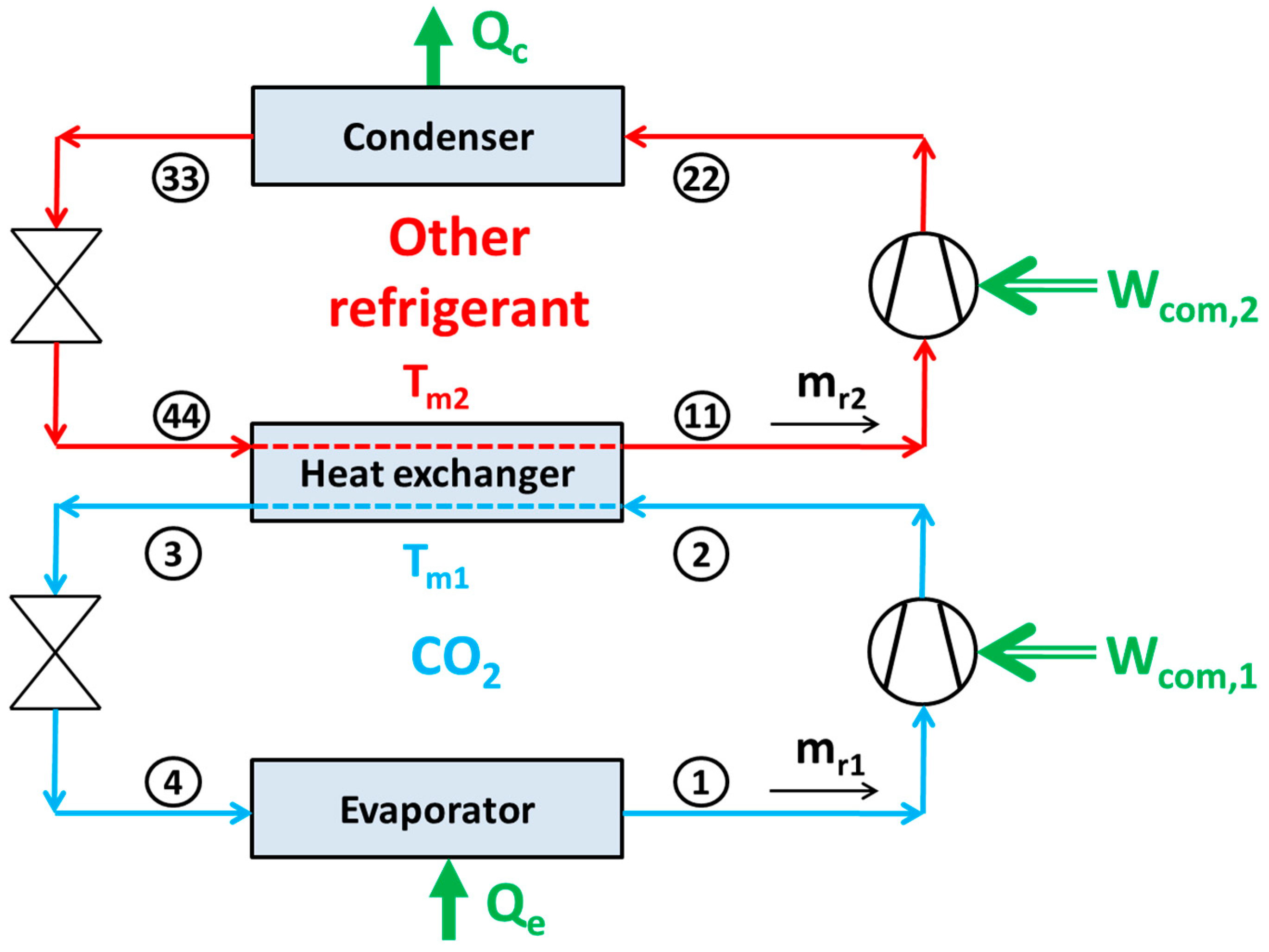
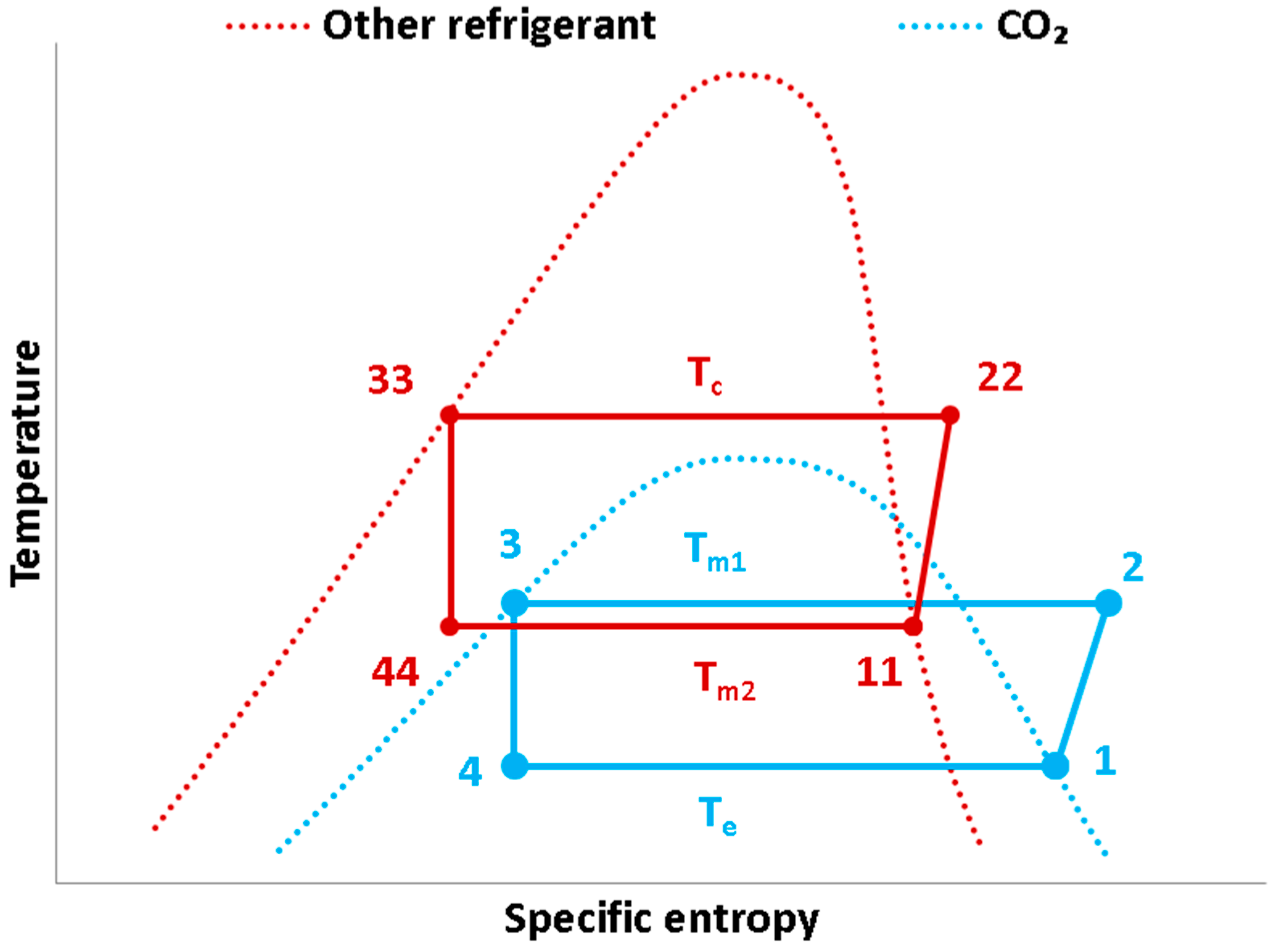

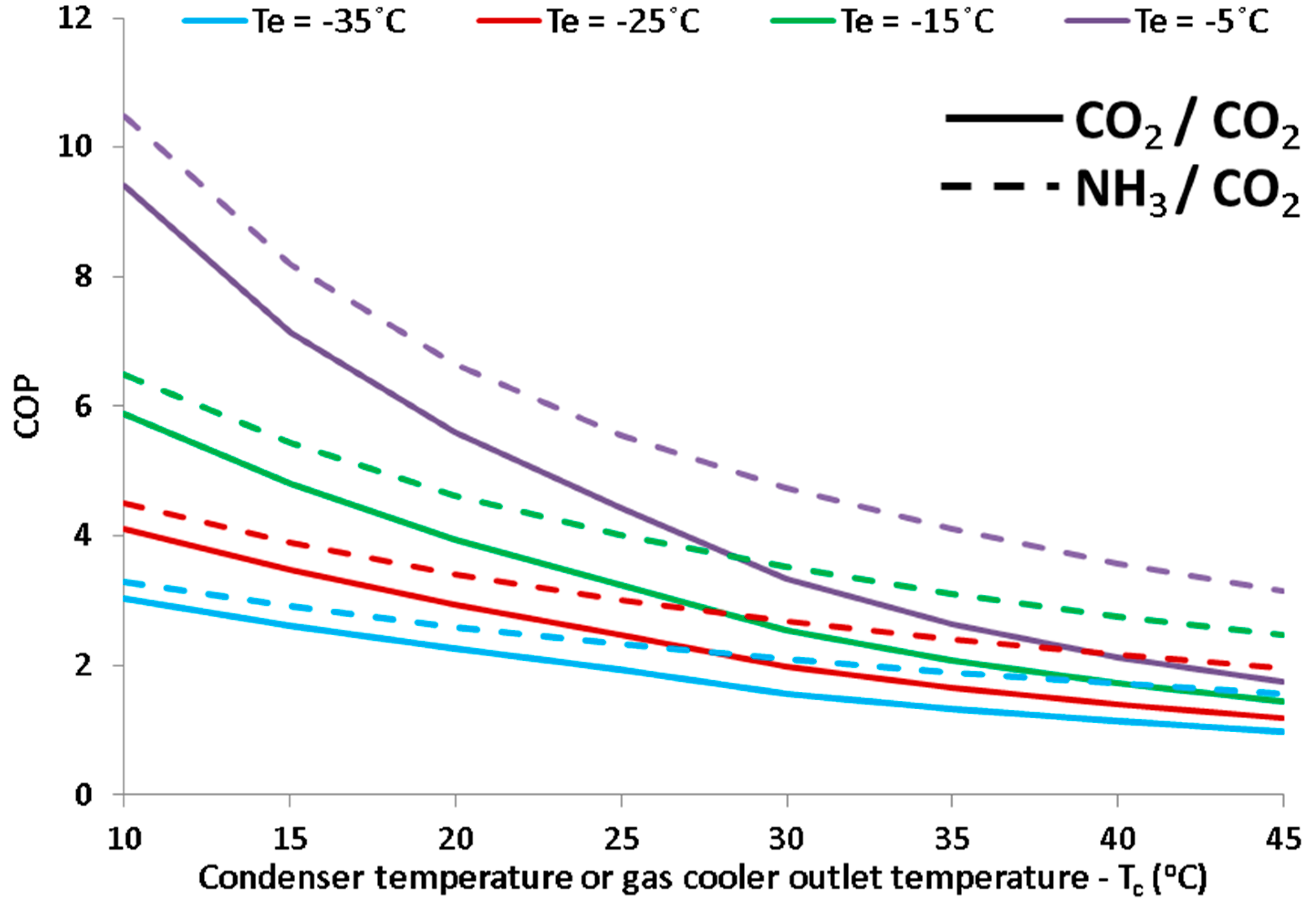


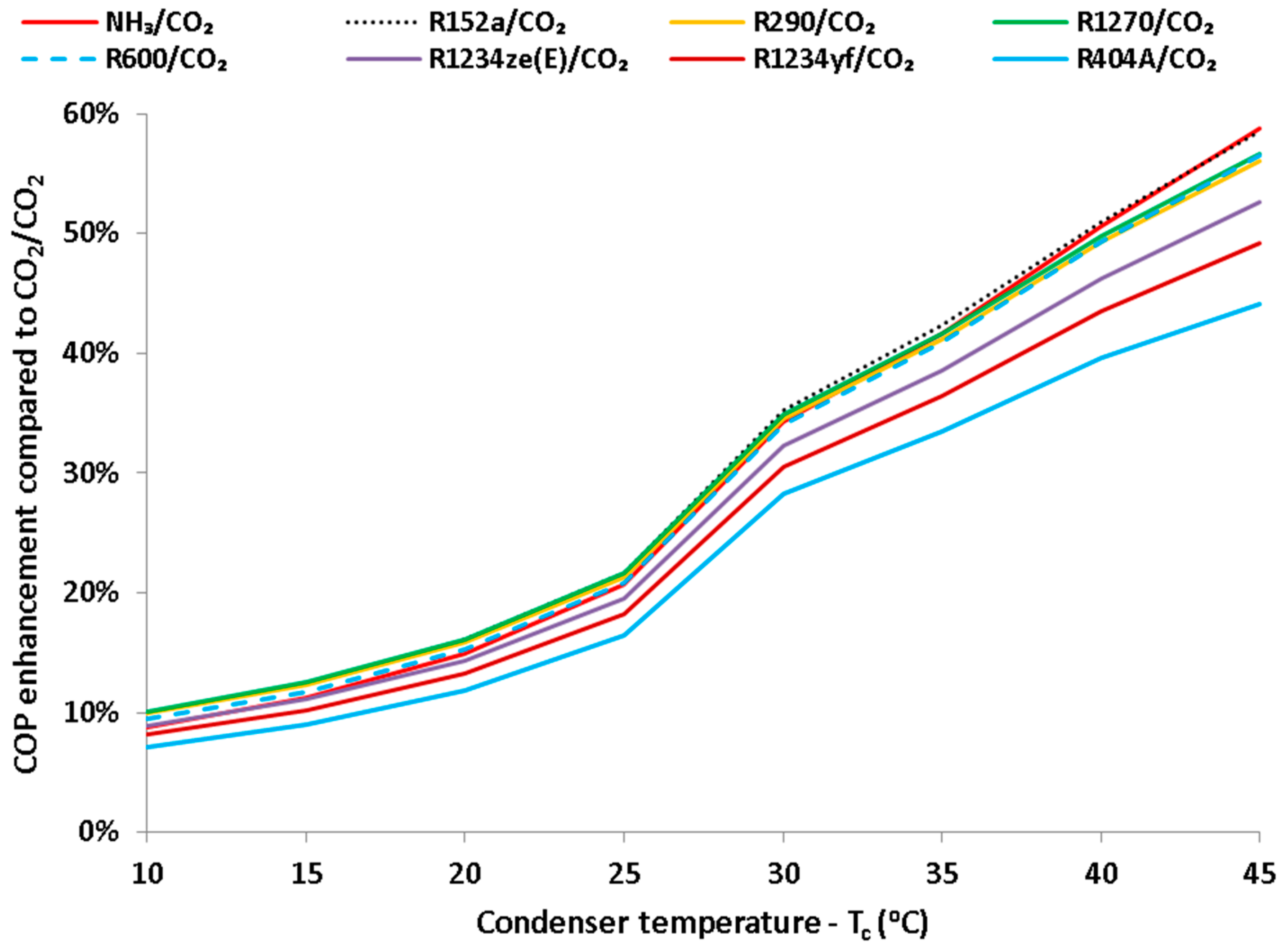
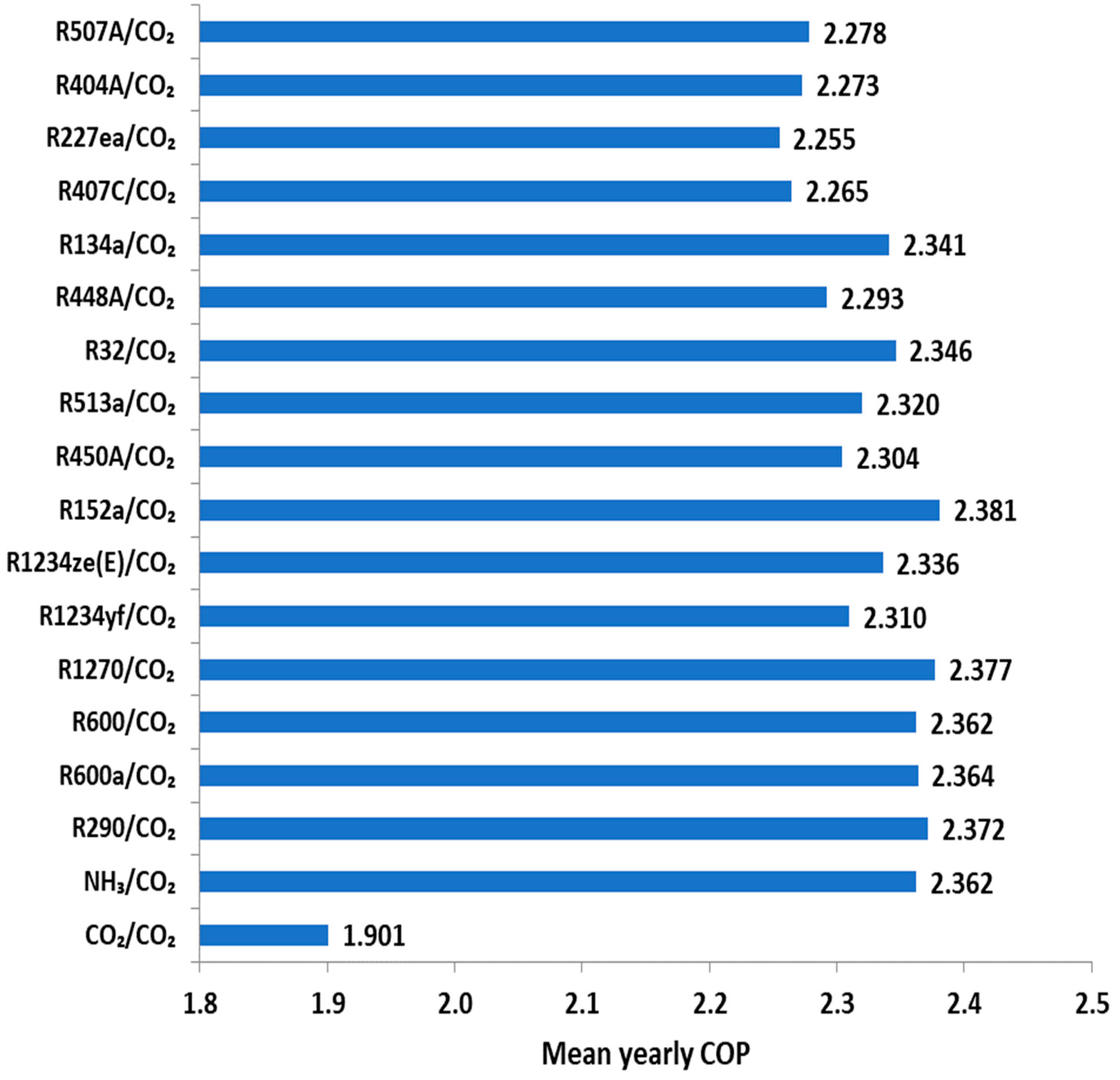

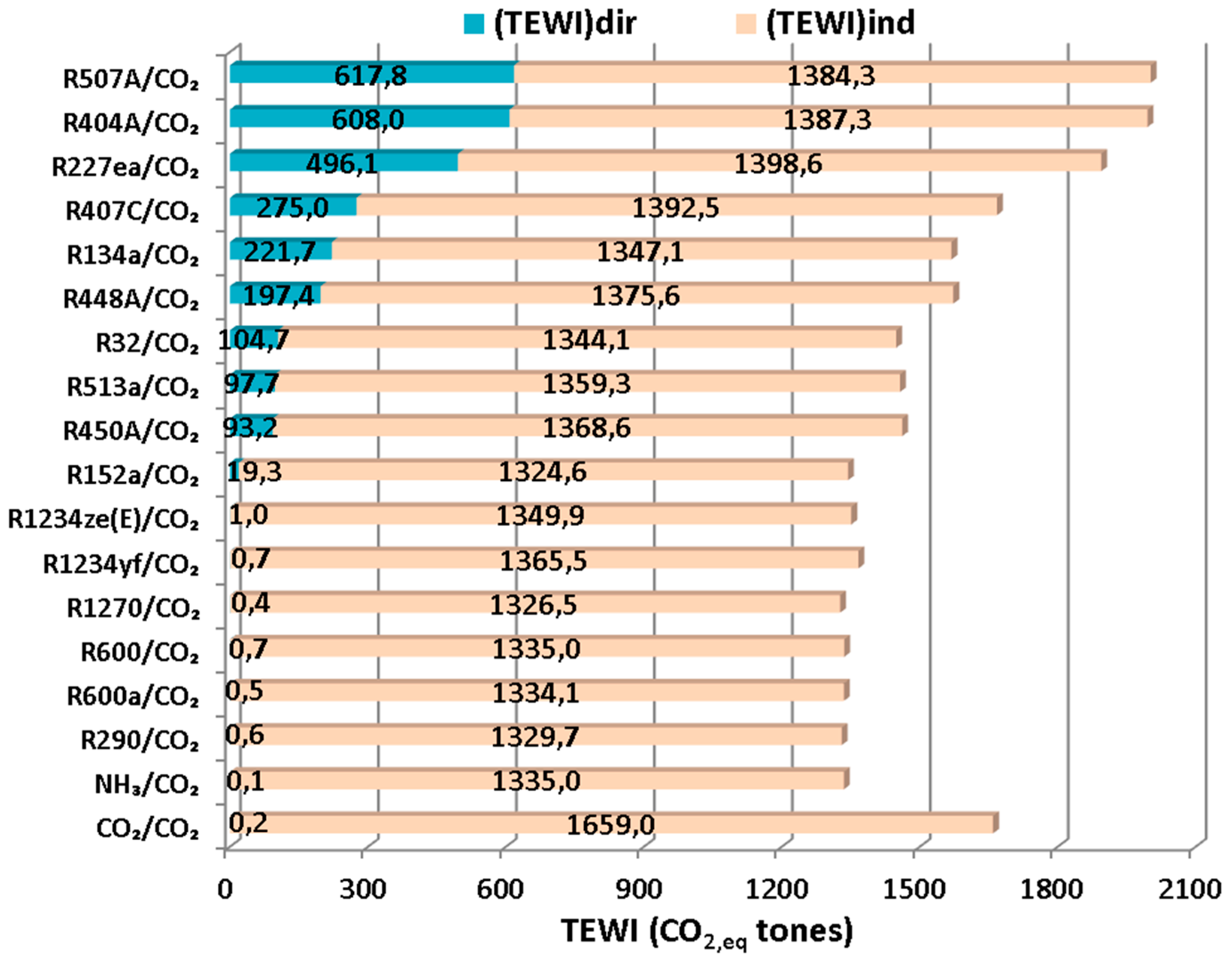
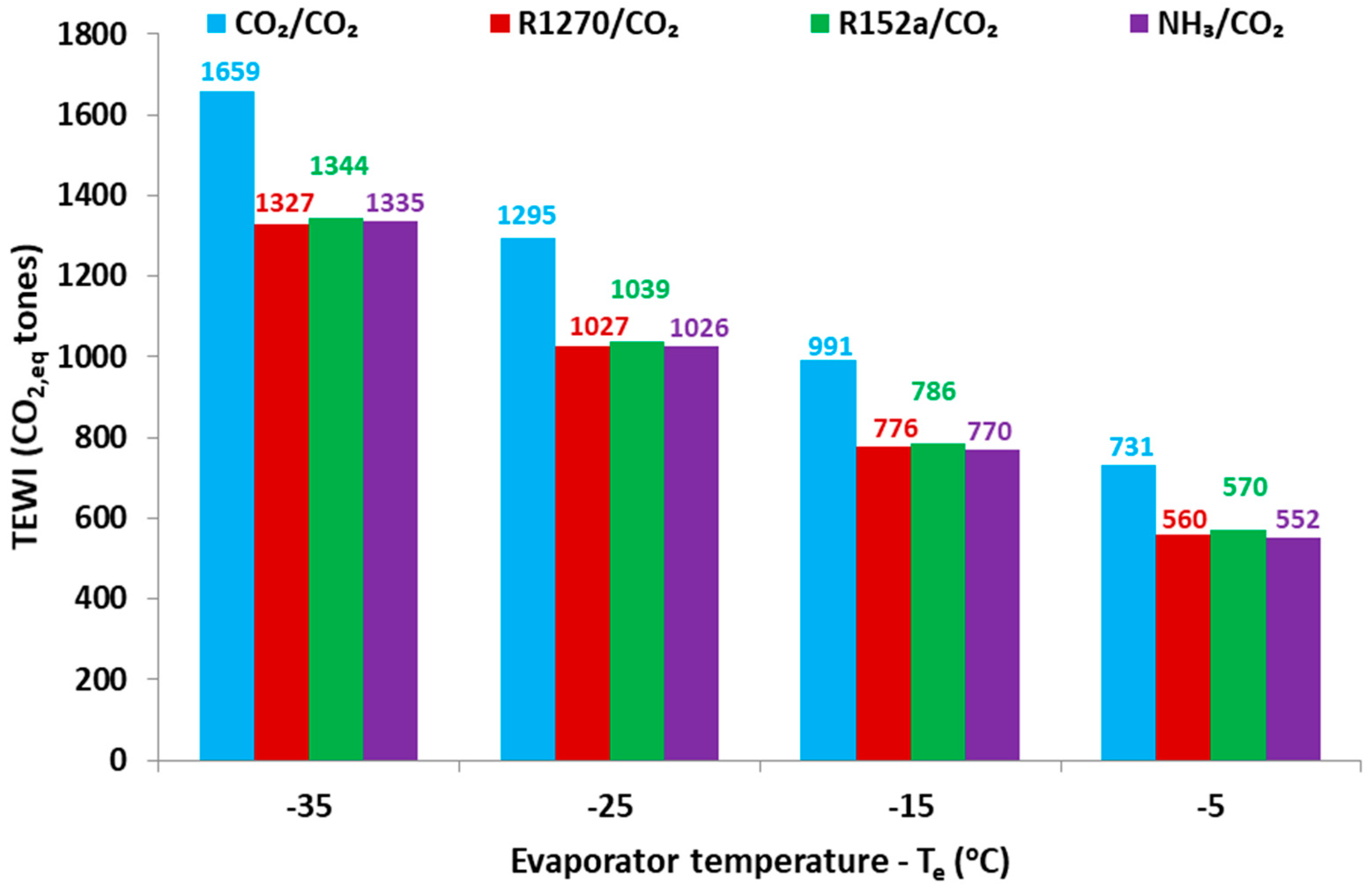
| Working Fluids | Classification | GWP (100 Years) | ASHRAE Safety Group | Limitations |
|---|---|---|---|---|
| R744 (CO2) | Natural refrigerant | 1 | A1 | Low COP |
| R717 (NH3) | Natural refrigerant | 0 | B2L | High Toxicity |
| R290 (propane) | HC (Natural refrigerant) | 3.3 | A3 | High flammability |
| R600a (iso-butane) | HC (Natural refrigerant) | 3 | A3 | High flammability |
| R600 (butane) | HC (Natural refrigerant) | 4 | A3 | High flammability |
| R1270 (propylene) | HO (Natural refrigerant) | 1.8 | A3 | High flammability |
| R1234yf | HFO | 4 | A2L | Low flammability, Stability issues |
| R1234ze(E) | HFO | 6 | A2L | Low flammability, Stability issues |
| R152a | HFC | 124 | A2 | Intermediate Flammability, Low GWP |
| R450A | HFO | 601 | A1 | High GWP > 150 |
| R513A | HFO | 630 | A1 | High GWP > 150 |
| R32 | HFC | 675 | A2L | Low flammability, Medium GWP |
| R448A | HFO | 1273 | A1 | High GWP |
| R134a | HFC | 1430 | A1 | High GWP |
| R407C | HFC | 1774 | A1 | High GWP |
| R227ea | HFC | 3200 | A1 | High GWP |
| R404A | HFC | 3922 | A1 | High GWP |
| R507A | HFC | 3985 | A1 | High GWP |
| Cases | Literature | This Study | Deviation | ||||
|---|---|---|---|---|---|---|---|
| Tc (°C) | Te (°C) | Tm1,opt (°C) | COP | Tm1,opt (°C) | COP | Tm1,opt (°C) | COP |
| 30 | −45 | −15 | 1.44 | −15.01 | 1.427 | 0.07% | 0.90% |
| 30 | −50 | −17 | 1.27 | −17.12 | 1.250 | 0.71% | 1.57% |
| 30 | −55 | −19 | 1.10 | −19.16 | 1.089 | 0.84% | 1.00% |
| 35 | −45 | −13 | 1.31 | −13.00 | 1.298 | 0.00% | 0.92% |
| 35 | −50 | −15 | 1.15 | −15.04 | 1.138 | 0.27% | 1.04% |
| 35 | −55 | −17 | 1.01 | −17.01 | 0.991 | 0.06% | 1.88% |
| 40 | −45 | −11 | 1.20 | −10.98 | 1.182 | 0.18% | 1.50% |
| 40 | −50 | −13 | 1.05 | −12.96 | 1.037 | 0.31% | 1.24% |
| 40 | −55 | −15 | 0.92 | −14.86 | 0.903 | 0.93% | 1.85% |
| Refrigerants | Yearly Mean COP | |||
|---|---|---|---|---|
| Te = −35 °C | Te = −25 °C | Te = −15 °C | Te = −5 °C | |
| CO2/CO2 | 1.901 | 2.436 | 3.183 | 4.315 |
| NH3/CO2 | 2.362 | 3.075 | 4.097 | 5.712 |
| R290/CO2 | 2.372 | 3.067 | 4.064 | 5.636 |
| R600a/CO2 | 2.364 | 3.072 | 4.088 | 5.693 |
| R600/CO2 | 2.362 | 3.075 | 4.097 | 5.712 |
| R1270/CO2 | 2.377 | 3.070 | 4.064 | 5.631 |
| R1234yf/CO2 | 2.310 | 3.001 | 3.991 | 5.552 |
| R1234ze(E)/CO2 | 2.336 | 3.040 | 4.050 | 5.645 |
| R152a/CO2 | 2.381 | 3.092 | 4.112 | 5.722 |
| R450A/CO2 | 2.304 | 2.996 | 3.987 | 5.547 |
| R513a/CO2 | 2.320 | 3.014 | 4.008 | 5.576 |
| R32/CO2 | 2.346 | 3.036 | 4.023 | 5.578 |
| R448A/CO2 | 2.293 | 2.973 | 3.947 | 5.477 |
| R134a/CO2 | 2.341 | 3.043 | 4.049 | 5.637 |
| R407C/CO2 | 2.265 | 2.937 | 3.895 | 5.399 |
| R227ea/CO2 | 2.255 | 2.944 | 3.929 | 5.483 |
| R404A/CO2 | 2.273 | 2.946 | 3.909 | 5.421 |
| R507A/CO2 | 2.278 | 2.953 | 3.918 | 5.434 |
| Refrigerants | TEWI (CO2,eq Tones) | |||
|---|---|---|---|---|
| Te = −35 °C | Te = −25 °C | Te = −15 °C | Te = −5 °C | |
| CO2/CO2 | 1659.2 | 1294.6 | 990.9 | 731.1 |
| NH3/CO2 | 1335.1 | 1025.7 | 769.8 | 552.1 |
| R290/CO2 | 1330.3 | 1028.9 | 776.7 | 560.1 |
| R600a/CO2 | 1334.6 | 1027.1 | 772.0 | 554.5 |
| R600/CO2 | 1335.7 | 1026.3 | 770.5 | 552.8 |
| R1270/CO2 | 1326.9 | 1027.4 | 776.3 | 560.4 |
| R1234yf/CO2 | 1366.2 | 1051.6 | 790.9 | 568.7 |
| R1234ze(E)/CO2 | 1351.0 | 1038.2 | 779.6 | 559.7 |
| R152a/CO2 | 1343.9 | 1039.2 | 786.3 | 570.5 |
| R450A/CO2 | 1461.8 | 1145.7 | 884.3 | 661.8 |
| R513a/CO2 | 1457.0 | 1144.0 | 884.5 | 663.3 |
| R32/CO2 | 1448.8 | 1143.6 | 888.6 | 670.0 |
| R448A/CO2 | 1573.0 | 1258.0 | 996.5 | 773.2 |
| R134a/CO2 | 1568.9 | 1258.0 | 1000.6 | 781.2 |
| R407C/CO2 | 1667.6 | 1348.9 | 1084.6 | 859.1 |
| R227ea/CO2 | 1894.6 | 1567.4 | 1298.7 | 1071.3 |
| R404A/CO2 | 1995.3 | 1678.3 | 1414.8 | 1189.7 |
| R507A/CO2 | 2002.0 | 1685.7 | 1422.7 | 1198.1 |
© 2019 by the authors. Licensee MDPI, Basel, Switzerland. This article is an open access article distributed under the terms and conditions of the Creative Commons Attribution (CC BY) license (http://creativecommons.org/licenses/by/4.0/).
Share and Cite
Bellos, E.; Tzivanidis, C. A Theoretical Comparative Study of CO2 Cascade Refrigeration Systems. Appl. Sci. 2019, 9, 790. https://doi.org/10.3390/app9040790
Bellos E, Tzivanidis C. A Theoretical Comparative Study of CO2 Cascade Refrigeration Systems. Applied Sciences. 2019; 9(4):790. https://doi.org/10.3390/app9040790
Chicago/Turabian StyleBellos, Evangelos, and Christos Tzivanidis. 2019. "A Theoretical Comparative Study of CO2 Cascade Refrigeration Systems" Applied Sciences 9, no. 4: 790. https://doi.org/10.3390/app9040790
APA StyleBellos, E., & Tzivanidis, C. (2019). A Theoretical Comparative Study of CO2 Cascade Refrigeration Systems. Applied Sciences, 9(4), 790. https://doi.org/10.3390/app9040790






